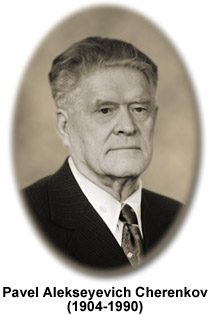Pavel Alekseyevich Cherenkov
(1904-1990)

The son of Russian peasants, Pavel Cherenkov faced a significant amount of adversity in his life, but admirably persevered. He was born in the village of Novaya Chigla in the Vornezh province and grew up in a tumultuous time when Russia was engaged in war and revolution. At the age of two, Cherenkov lost his mother and his father soon remarried, consigning much of his and his sisterís upbringing to a stepmother. Later in his life, in 1938, he would also prematurely lose his father, who was killed under Stalinís regime for political reasons. As a child, Cherenkov reportedly exhibited a curious nature, was an avid reader, and performed well in school. In college, he studied mathematics and physics, graduating in 1928 from Vornezh University. Subsequently, in 1930, he married Marya Putintseva, with whom he would have two children, and relocated to Leningrad (now known as St. Petersburg) to embark upon postgraduate research at the P.N. Lebedev Institute of Physics in the Academy of Sciences.
Cherenkovís initial postgraduate work in optics was supervised by Sergei Vavilov. However, the primary topic of his original research was of diminished interest by 1934 due to a weak blue background light that interfered with his studies. When he first discovered this light, it was emitted from a bottle of water subjected to radioactive bombardment. The unusual optical phenomenon, which fascinated Cherenkov to such an extent that he spent six years of his life characterizing it, is now known as the Cherenkov effect and is perhaps most familiar to the general public as a bluish glow signifying radioactive material in movies. The Cherenkov effect occurs when charged particles move at speeds greater than the speed of light, causing a portion of the energy to be emitted as a kind of electromagnetic radiation termed Cherenkov radiation. This scenario is made possible by the fact that light travels more slowly through a transparent medium than it does in a vacuum, so that in air, water, and certain other substances, elementary particles may surpass the velocity of light in that medium.
Although early on, Cherenkovís devoted study to the optical effect and special form of electromagnetic radiation that now bear his name was derided by some of his colleagues who believed it to be a pointless endeavor, in time the utility of the strange bluish glow would become apparent. Today, the Cherenkov effect is considered invaluable to the field of spectroscopy, as well as to the study of cosmic rays and other high-speed particles. Cherenkov counters, which are specialized instruments that can measure particle velocity by using the light emitted by Cherenkov radiation, have garnered widespread use by experimental scientists studying particle and nuclear physics. Devices known as DIRC-counters (Detection of Internally Reflected Cherenkov light), which measure the angle (termed the Cherenkov angle) from which Cherenkov radiation can be observed with respect to the fast-moving charged particle that causes it release, are also commonly used for physics research.
In 1958, Pavel Cherenkov was awarded the Nobel Prize in Physics for his discovery and characterization of the Cherenkov effect. He shared that yearís prize with Ilya Frank and Igor Tamm, the physicists who developed the theoretical explanation of the optical effect. The following year, Cherenkov was rendered full control of the photo-meson processes laboratory at the Lebedev Institute, where he had already gained his doctorate (1940) and been appointed as a full professor of experimental physics (1953). By the time of his death in 1990, Cherenkov had enjoyed a long and successful career at the Institute that spanned six decades.
